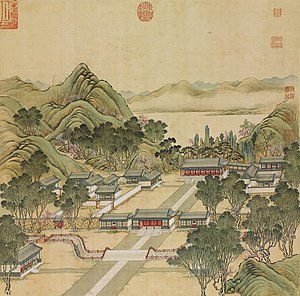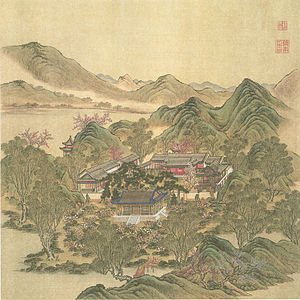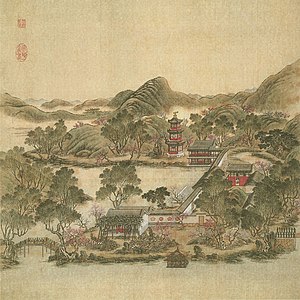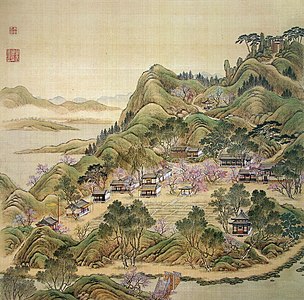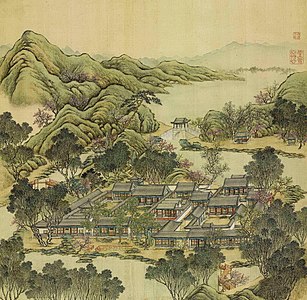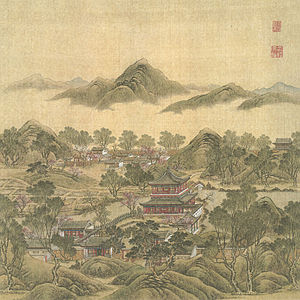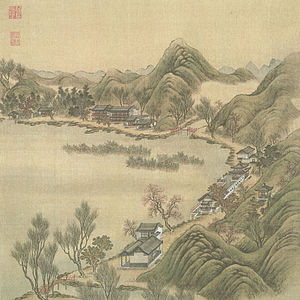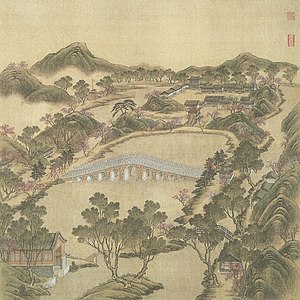
The traditional Chinese calendar is a lunisolar calendar, combining the solar, lunar, and other cycles for various social and religious purposes. More recently, in China and Chinese communities the Gregorian calendar has been adopted and adapted in various ways, and is generally the basis for standard civic purposes, but incorporating traditional lunisolar holidays. However, there are many types and subtypes of the Chinese calendar, partly reflecting developments in astronomical observation and horology, with over a millennium plus history. The major modern form is the Gregorian calendar-based official version of the Mainland China, although diaspora versions are also notable in other parts of China and Chinese-influenced cultures; however, aspects of the traditional lunisolar calendar remain popular, including the association of the twelve animals of the Chinese Zodiac in relation to months and years.
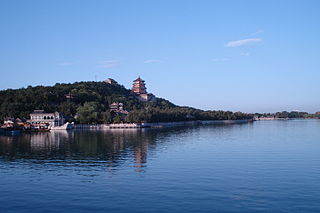
The Summer Palace is a vast ensemble of lakes, gardens and palaces in Beijing. It was an imperial garden in the Qing dynasty. Inside includes Longevity Hill Kunming Lake and Seventeen Hole Bridge. It covers an expanse of 2.9 square kilometres (1.1 sq mi), three-quarters of which is water.
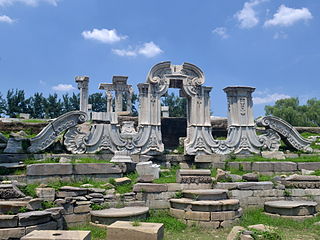
The Old Summer Palace, also known as Yuanmingyuan or Yuanmingyuan Park, originally called the Imperial Gardens, and sometimes called the Winter Palace, was a complex of palaces and gardens in present-day Haidian District, Beijing, China. It is 8 kilometres (5 mi) north-west of the walls of the former Imperial City section of Beijing. Widely perceived as the pinnacle work of Chinese imperial garden and palace design, the Old Summer Palace was known for its extensive collection of gardens, its building architecture and numerous art and historical treasures. Constructed throughout the 18th and early 19th centuries, the Old Summer Palace was the main imperial residence of Qianlong Emperor of the Qing dynasty and his successors, and where they handled state affairs; the Forbidden City was used for formal ceremonies. The Garden was reputed as the "Garden of Gardens" in its heyday was "arguably the greatest concentration of historic treasures in the world, dating and representing a full 5,000 years of an ancient civilization", according to Robert McGee, chaplain to the British forces.

Tianlong is a flying dragon in Chinese mythology, a star in Chinese astrology, and a proper name.

Mount Tai is a mountain of historical and cultural significance located north of the city of Tai'an. It is the highest point in Shandong province, China. The tallest peak is the Jade Emperor Peak, which is commonly reported as being 1,545 meters (5,069 ft) tall.
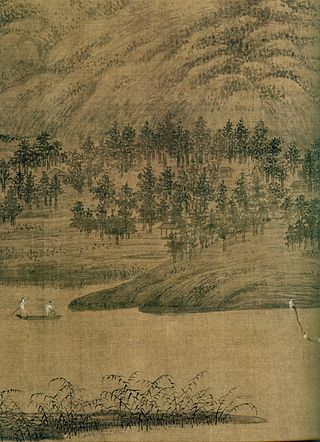
Dong Yuan was a Chinese painter.

The Long Corridor is a covered walkway in the Summer Palace in Beijing, China. First erected in the middle of the 18th century, it is famous for its 728 m (2,388 ft) length in conjunction with its rich painted decoration.
Xuan-Yuan Sword is a long-running historical fantasy role-playing video game series developed for personal computers by the DOMO Studio (DOMO小組/多魔小組) of the Taiwanese game developer Softstar Entertainment. The games incorporate heavily elements of Chinese mythology, and is one of the so-called "Twin Swords of Softstar" (大宇雙劍) along with The Legend of Sword and Fairy, a sister fantasy RPG series also developed by Softstar.

Yuanshi Tianzun, the Celestial Venerable of the Primordial Beginning or the Primeval Lord of Heaven, is one of the highest deities of Taoism. He is one of the Three Pure Ones and is also known as the Jade Pure One. He resides in the Great Web or the Heaven of Jade Purity. It is believed that he came into being at the beginning of the universe as a result of the merging of pure breaths. He then created Heaven and Earth.

The White Cloud Temple, also known as Baiyun Temple or the Abbey or Monastery of the White Clouds, is a Taoist temple and monastery located in Beijing, China. It is one of "The Three Great Ancestral Courts" of the Quanzhen School of Taoism and is titled "The First Temple under Heaven".

Daming Lake (Chinese: 大明湖; pinyin: Dàmíng Hú; Wade–Giles: Ta4-ming2 Hu2; lit. 'Lake of the Great Splendour') is the largest lake in the city of Jinan, Shandong, China and one of city's main natural and cultural landmarks. Located to the north of the historical city center, the lake is fed by the artesian karst springs of the area and hence retains a fairly constant water level through the entire year.
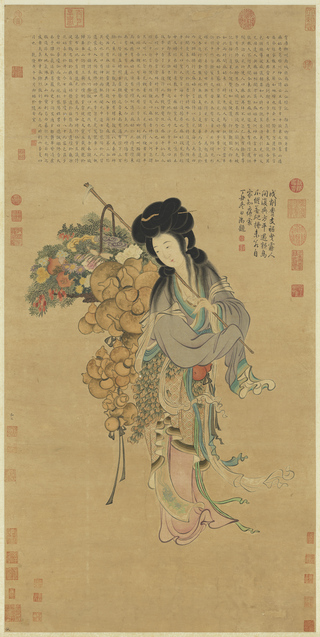
Magu is a legendary Taoist xian associated with the elixir of life, and a symbolic protector of women in Chinese mythology. Stories in Chinese literature describe Magu as a beautiful young woman with long birdlike fingernails, while early myths associate her with caves. Magu xian shou is a popular motif in Chinese art.

The Eight Views of Xiaoxiang are scenes of the Xiaoxiang region, in what is now modern Hunan Province, China, that were the subject of the poems and depicted in well-known drawings and paintings from the time of the Song Dynasty. The Eight Views of Xiaoxiang can refer either to various sets of paintings which have been done on this theme, the various verse series on the same theme, or to combinations of both. The Xiaoxiang theme is part of a long poetic and artistic legacy.

The Admonitions Scroll is a Chinese narrative painting on silk that is traditionally ascribed to Gu Kaizhi, but which modern scholarship regards as a 5th to 8th century work that may or may not be a copy of an original Jin dynasty (266–420) court painting by Gu. The full title of the painting is Admonitions of the Court Instructress. It was painted to illustrate a poetic text written in 292 by the poet-official Zhang Hua (232–300). The text itself was composed to reprimand Empress Jia (257–300) and to provide advice to the women in the imperial court. The painting illustrates this text with scenes depicting anecdotes about exemplary behaviour of historical palace ladies, as well as with more general scenes showing aspects of life as a palace lady.
The Eight Views of Ram City, also known as the Eight Sights of Guangzhou is the collective name for various collections of the eight most famous tourist attractions in Guangzhou, China, during different periods of its history. Collections of "Eight Views" is a common trope in Chinese travel literature.
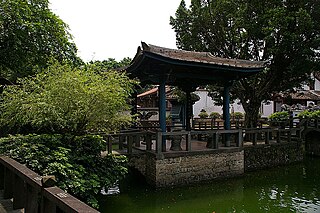
The Lin Ben Yuan Family Mansion and Garden in Banqiao District, New Taipei City, Taiwan was a residence built by the Lin Ben Yuan Family. It is Taiwan's most complete surviving example of traditional Chinese garden architecture. The Lin Family Mansion and Garden — along with the Tainan Wu Garden, Hsinchu Beiguo Garden (新竹北郭園), and Wufeng Lin Family Mansion and Garden — are collectively known as the Four Great Gardens of Taiwan (台灣四大名園). This residence can be traced back to 1847, at the time a "rent house" for the Lin Ben Yuan family in the north. It was later expanded by the brothers Lin Guohua and Lin Guofang, becoming the residence of the Lin Ben Yuan family. Currently, the Lin Family Mansion and Garden is under the joint responsibility of the Executive Yuan Cultural Construction Committee, Ministry of the Interior, Ministry of Transportation and Communications Tourism Bureau, Taiwan Provincial Government, and the New Taipei City Government for protection and restoration work, who have additionally designated it as a Class-2 Historical Site.

Sermon on Mani's Teaching of Salvation is a Yuan dynasty silk hanging scroll, measuring 142 × 59 centimetres and dating from the 13th century, with didactic themes: a multi-scenic narrative that depicts Mani's Teachings about the Salvation combines a sermon subscene with the depictions of soteriological teaching in the rest of the painting.

Terlig, also known as tieli or bianxianao or Yaoxianao[zi] in Chinese, or commonly referred as Mongol dress or plait-line robe, is an archetypal type of Mongol clothing for men.

Tongtianguanfu is a form of court attire in hanfu which was worn by the Emperor during the Song dynasty on very important occasions, such as grand court sessions and during major title-granting ceremonies. The attire traces its origin from the Han Dynasty.It was also worn in the Jin dynasty Emperors when the apparel system of the Song dynasty was imitated and formed their own carriages and apparel system, and in the Ming dynasty. The tongtianguanfu was composed of a red outer robe, a white inner robe, a bixi, and a guan called tongtianguan, and a neck accessory called fangxin quling.

Till the End of the Moon is a Chinese television series based on the novel Black Moonlight Holds the BE Script (黑月光拿稳BE剧本) by Teng Luo Wei Zhi (藤萝为枝), starring Luo Yunxi and Bai Lu. The series aired on Youku with 40 episodes on April 6, 2023. The drama was an international and domestic success breaking several records.
